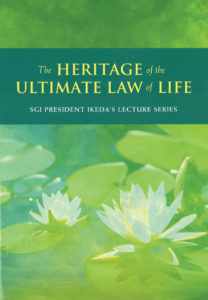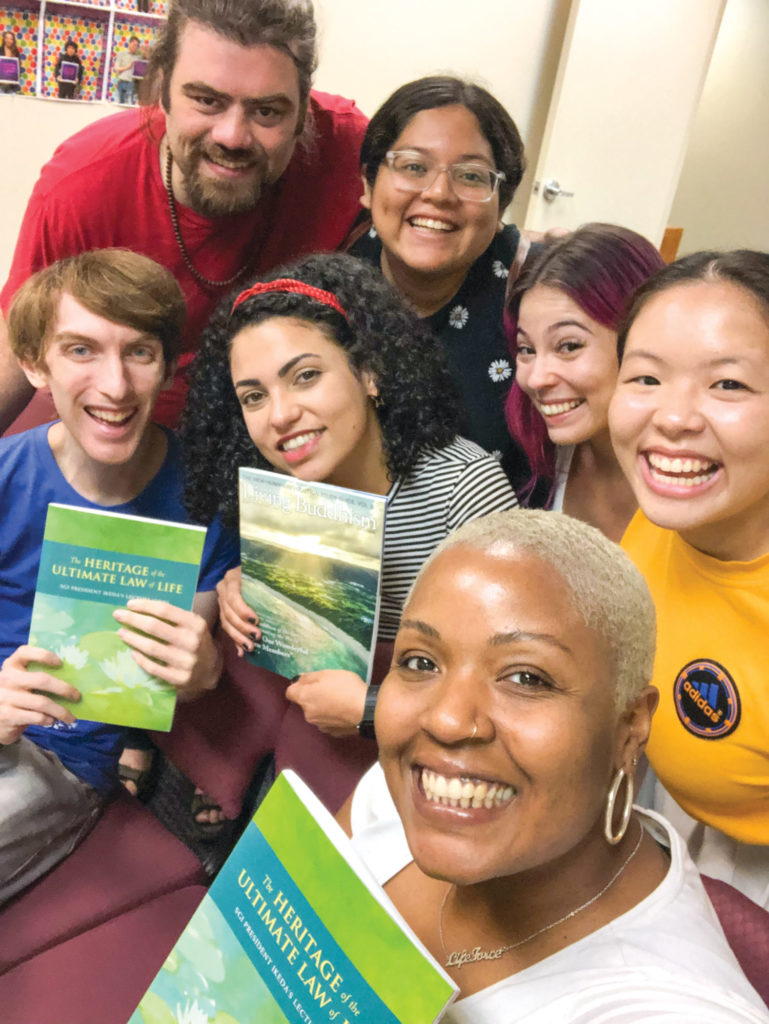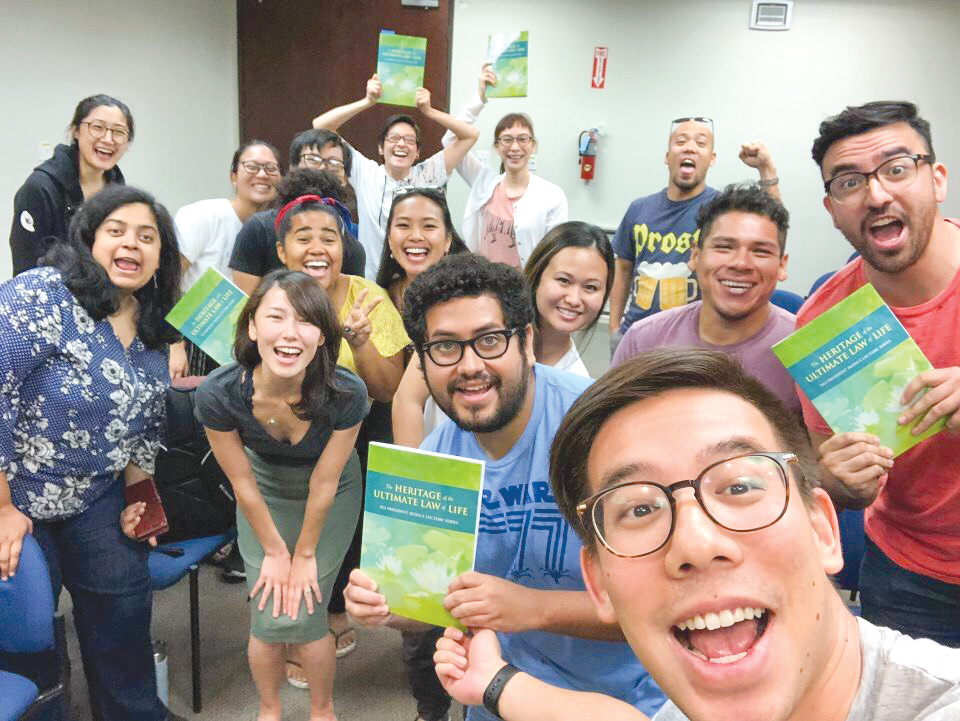The Ikeda Wisdom Academy is an SGI-USA youth division movement to engage youth leaders in advanced study. This month, academy members will study chapter 4 of The Heritage of the Ultimate Law of Life: SGI President Ikeda’s Lecture Series.
While the Ikeda Wisdom Academy is a youth leaders study program, all SGI-USA members are invited to utilize this section of Living Buddhism as a guide for their personal study of “The Heritage of the Ultimate Law of Life.”
– – – – – – – – – – – – – – – – – – – – – – – – – – – –
Syllabus – October 2019
The Heritage of the Ultimate Law of Life: SGI President Ikeda’s Lecture Series, Chapter 4
– – – – – – – – – – – – – – – – – – – – – – – – – – – –

Chapter 4
Life and Death as Functions of Myoho-Renge-Kyo—A Compassionate and Hope-filled View of Life and Death

In this passage, Nichiren clarifies the true nature of birth and death. Further, by teaching the essence of the Lotus Sutra in the Latter Day of the Law, he opens the way for all people to eliminate their delusion, which is the source of suffering, and attain eternal happiness over the three existences of past, present and future. The Daishonin specifically addresses delusions about death as the ultimate problem to overcome.
The Two Phases of Life and Death Indicate Life’s Boundless Potential
Myo represents death, and ho, life. Living beings that pass through the two phases of life and death are the entities of the Ten Worlds, or the entities of Myoho-renge-kyo [literally, “or the lotus of the entity”].
T’ien-t’ai says that one should understand that living beings and their environments, and the causes and effects at work within them, are all the Law of renge (the lotus). Here “living beings and their environments” means the phenomena of life and death. Thus, it is clear that, where life and death exist, cause and effect, or the Law of the lotus, is at work.
The Great Teacher Dengyo states, “The two phases of life and death are the wonderful workings of one mind. The two ways of existence and nonexistence are the true functions of an inherently enlightened mind.” No phenomena—either heaven or earth, yin or yang, the sun or the moon, the five planets, or any of the worlds from hell to Buddhahood—are free from the two phases of life and death. Life and death are simply the two functions of Myoho-renge-kyo. In his Great Concentration and Insight, T’ien-t’ai says, “Arising is the arising of the essential nature of the Law, and extinction is the extinction of that nature.” Shakyamuni and Many Treasures, the two Buddhas, are also the two phases of life and death. (The Writings of Nichiren Daishonin, vol. 1, p. 216)
Nichiren indicates that these two phases, life and death, form an inherent and integral part of the Mystic Law, the fundamental Law of the universe, and that living beings of the Ten Worlds who pass through these two phases are all entities of that Law. This means that the life and death of those who dwell in this saha world are not originally characterized by suffering and delusion but are part of the eternal rhythm of the Mystic Law itself. This is the essence of the Buddha’s enlightenment to the true aspect of the threefold world, which is described in the “Life Span” chapter of the Lotus Sutra. (The Heritage of the Ultimate Law of Life: SGI President Ikeda’s Lecture Series, pp. 31–32)
The Entity of Myoho-renge-kyo Indicates Life’s Transformative Potential
To further clarify the true nature of the life and death of living beings of the Ten Worlds, Nichiren Daishonin next speaks about the “entity of Myoho-renge-kyo,” which in this passage literally translates as the “lotus of the entity,” or the “embodied lotus.” The “embodied lotus” represents the principle that all living beings of the Ten Worlds are entities of the Mystic Law. It means that the lives of all living beings here and now are entities of the mutual possession of the Ten Worlds and have the potential to manifest the highest world of Buddhahood just as they are.
■ ■ ■
When viewed in terms of the entity of Myoho-renge-kyo, or “embodied lotus,” our lives, which undergo the cycle of birth and death, are neither inherently good nor evil. Based on different causes and conditions, they can undergo a state of delusion or a state of enlightenment. In terms of the Ten Worlds, our lives have the innate potential to embody any of the worlds from hell to Buddhahood; this represents the true nature of our lives. (Lecture Series, 32–33)

White Plains, New York
The Simultaneity of Cause and Effect Is the Foundation of Inner Transformation
Next, to amplify the meaning of the entity of Myoho-renge-kyo, or “embodied lotus,” Nichiren Daishonin cites a passage by T’ien-t’ai: “Living beings and their environments, and the causes and effects at work within them, are all the Law of renge (the lotus)” (WND-1, 216). Here, “living beings and their environments” refers to life activity itself, which undergoes the two phases of life and death. The relationship among life activity and living beings and their environments is now being studied scientifically as well.
Various causal phenomena occur in living beings, in their environments and also between living beings and their environments. Nichiren says that all these phenomena are simply part of the phases of life and death, which are inherent in the Mystic Law. This means that the various causal phenomena involving living beings and their environments also essentially arise in accord with the “Law of the lotus,” the law of the simultaneity of cause and effect. In other words, this law is at work in living beings and their environments. What is the practical implication of this truth? Nichiren teaches that when we change our fundamental attitude or mindset, we can instantly transform both our lives and our environments. (Lecture Series, 33)
All Changing Phenomena Are Manifestations of the Phases of Life and Death of the Mystic Law
So far, our discussion of the Mystic Law and the lotus has shown that Myoho-renge-kyo is a great Law that teaches the profound significance of the life and death of living beings. Nichiren Daishonin concludes that all birth and death, and all change, are manifestations of the phases of life and death, which are inherent functions of Myoho-renge-kyo.
First, he cites a passage from a commentary by the Great Teacher Dengyo of Japan, which states: “The two phases of life and death are the wonderful workings of one mind. The two ways of existence and nonexistence are the true functions of an inherently enlightened mind” (WND-1, 216). This is to clarify that all change derives from the one ultimate Law—the Mystic Law of the simultaneity of cause and effect.
“The wonderful workings of one mind” might be more easily understood if explained as the principle of “three thousand realms in a single moment of life.” A change in our mind or single life-moment can greatly alter our state of life and open up our world. This is because our lives, as entities of the mutual possession of the Ten Worlds, are endowed with the transformative potential to bring forth any of the three thousand realms, that is, all the potential of the entire universe.
Next, Nichiren writes: “No phenomena—either heaven or earth, yin or yang, the sun or the moon, the five planets, or any of the worlds from hell to Buddhahood—are free from the two phases of life and death” (WND-1, 216). Because Buddhism teaches the principles of “three thousand realms in a single moment of life” and “the mutually inclusive relationship of a single moment of life and all phenomena,” environmental factors such as “heaven or earth,” “yin or yang,” “the sun or the moon” and “the five planets” are also entities of the Mystic Law that go through the phases of life and death. This is also true of living beings and environments of the Ten Worlds, here indicated by “any of the worlds from hell to Buddhahood.”
■ ■ ■
Nichiren is saying that heaven and earth, as well as the forces of yin and yang that underlie them, along with the sun and moon and the five elements, are ultimately all manifestations of the phases of life and death that are inherent functions of Myoho-renge-kyo. Indeed, this is true of all phenomena, as indicated by the statement: “No phenomena . . . are free from the two phases of life and death” (WND-1, 216). (Lecture Series, 34–35)
The Two Buddhas Shakyamuni and Many Treasures Represent the Two Phases of Life and Death
Next, Nichiren Daishonin writes, “Shakyamuni and Many Treasures, the two Buddhas, are also the two phases of life and death” (WND-1, 216). The Buddhas Shakyamuni and Many Treasures seated side by side in the Treasure Tower during the Ceremony in the Air personify the world of Buddhahood inherent in Myoho-renge-kyo. Like us ordinary beings, they are entities of the Mystic Law and go through the phases of life and death.
In this passage, Shakyamuni represents the lord of teachings whose true identity is revealed in the essential teaching (the second half) of the Lotus Sutra. He is the Buddha who has constantly abided in this saha world to continue expounding the Mystic Law after attaining enlightenment in the remote past of numberless major world system dust particle kalpas.
In the “Life Span” chapter of the Lotus Sutra, Shakyamuni discloses that though he gained supreme enlightenment in the distant past and is a Buddha who abides constantly in the world without ever entering extinction, he has pretended to enter nirvana as an expedient means to guide living beings to enlightenment. Hence, his statement, “As an expedient means I appear to enter nirvana” (The Lotus Sutra and Its Opening and Closing Sutras, p. 271). This indicates how the entity of the Buddha’s life, though in essence the eternal Mystic Law, actually undergoes a transition from life to death on the phenomenal level.
As for Many Treasures Buddha, he is an ancient Buddha who attained enlightenment and entered nirvana in the distant past. He appears at the assembly where the Lotus Sutra is preached to attest to the truth of its teachings. His appearance can be said to symbolize an entity of the Mystic Law emerging from the phase of death into life.
In any event, for both Shakyamuni and Many Treasures, life and death are means for teaching and revealing the Mystic Law. Because they employ the phases of life and death inherent to all entities of the Mystic Law, these two Buddhas are also functions of the Mystic Law. (Lecture Series, 35)
The Life and Death of Living Beings in the World of Buddhahood
The life and death of all living beings are functions of Myoho-renge-kyo. Josei Toda often used to say that when we die, we merge with the universe. The life of the universe itself contains all of the Ten Worlds. It contains the worlds from hell and hunger right through to Buddhahood. When we die, our life essence fuses with one of these worlds in the universe—hell, hungry spirits, bodhisattva, Buddhahood and so forth—corresponding to our own inner state.
While we may say that our life essence fuses or merges with the life of the universe, strictly speaking, it is actually already part of the life of the universe itself; inherently, there is no separation between the two. In a sense, the universe is a great ocean of life, which is in a constant state of flux itself; it is continually moving and changing, performing the rhythm of birth and death.
■ ■ ■
When life and death are viewed in terms of the Mystic Law, there is no need to fear death. Death for living beings in the world of Buddhahood means becoming one with the universe that overflows with the workings of compassion. Then, when we are reborn, embodying the compassion and life force of the universe, we once again take vibrant action and conduct ourselves in the manner of a Buddha—in other words, taking the greatest joy in respecting others and working to lead all people to enlightenment. (Lecture Series, 36)
You are reading {{ meterCount }} of {{ meterMax }} free premium articles

